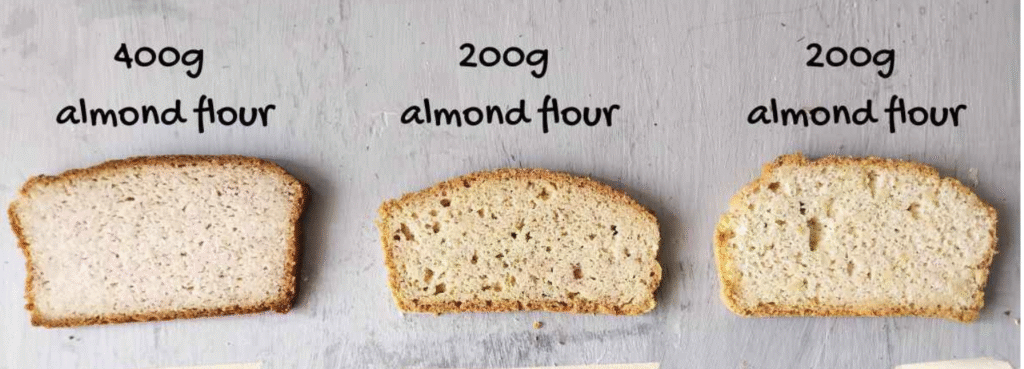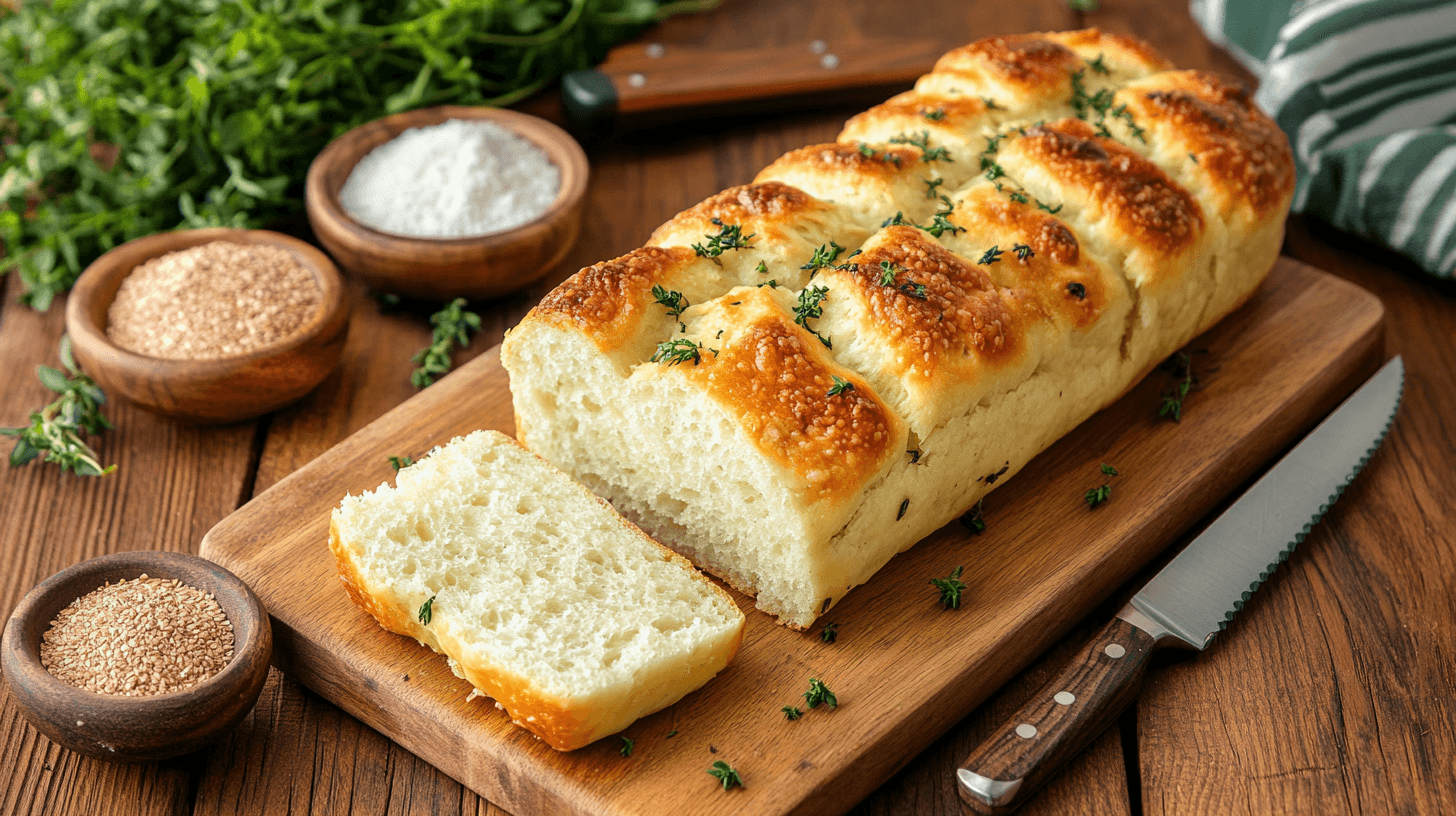Last updated on April 27th, 2025
When it comes to healthier food options, low carb gluten-free bread is rapidly becoming a favorite. With benefits ranging from better digestion to balanced blood sugar, this bread is ideal for a variety of diets, including keto and gluten-free lifestyles. Whether you’re looking to manage your weight, avoid gluten, or simply make healthier choices, this bread offers a delicious alternative to traditional loaves.
For additional tips on choosing healthy low-carb options, explore this Ultimate Guide to Low Carb Foods for ideas that can complement your meal plans.
Table of Contents
Understanding Low Carb Gluten-Free Bread
What Is Low Carb Gluten-Free Bread?
Low carb gluten-free bread is a type of bread that replaces traditional wheat flour with low-carb alternatives like almond flour, coconut flour, or flaxseed meal. Designed to reduce carbohydrates and eliminate gluten, it provides a nutritious and versatile option for people with specific dietary needs.
Who Should Try It?
- Celiac Disease or Gluten Intolerance: Gluten-free bread is essential for those with gluten sensitivities or celiac disease, ensuring they can enjoy bread without discomfort.
- Low-Carb or Keto Dieters: With fewer carbs per slice, this bread is ideal for those watching their carb intake or following a ketogenic diet.
- Health-Conscious Eaters: Even if you don’t have specific dietary restrictions, swapping regular bread for low carb gluten-free bread can help improve digestion and overall nutrition.
If you’re looking for a healthier, protein-packed alternative, consider pairing it with dishes like this Cottage Cheese Chips Recipe for a snack that’s both satisfying and low-carb.
Benefits of Low Carb Gluten-Free Bread
1. Aids in Weight Management
Reducing carb intake is a proven strategy for weight loss. With low carb gluten-free bread, you can enjoy your meals without compromising on your diet. The high fiber and protein content in ingredients like almond flour and flaxseed meal help keep you full, reducing the likelihood of overeating.
2. Gentle on Digestion
Unlike regular bread, which often contains gluten that can irritate the digestive system, this bread is gluten-free and much easier on the stomach. Ingredients like coconut flour are high in fiber, promoting gut health and reducing bloating.
3. Better Blood Sugar Control
The low-carb nature of this bread helps maintain stable blood sugar levels. This makes it an excellent option for people with diabetes or those managing insulin resistance.
For more ideas on creating balanced meals, pair this bread with wholesome sides like the hearty Baked Bean Recipe for a nutrient-packed plate.
Why It’s Growing in Popularity
1. Meets Dietary Needs
As awareness of gluten intolerance and carb sensitivities grows, more people are seeking bread options that cater to these requirements. Low carb gluten-free bread fits perfectly into this niche.
2. Easy to Customize
This bread is highly versatile, making it easy to adapt for different tastes. Whether you prefer savory or slightly sweet flavors, you can tweak recipes to suit your preferences.
3. Readily Available
Thanks to the popularity of keto and gluten-free diets, both pre-made and homemade options for low carb gluten-free bread are more accessible than ever. Grocery stores and online retailers now stock a wide variety, and there are countless simple recipes for home bakers.

Essential Features of Low Carb Gluten-Free Bread
1. Low in Carbs
While traditional bread often contains 15–20 grams of carbs per slice, low-carb versions typically have less than 5 grams. This significant reduction makes it an excellent choice for those on low-carb or ketogenic diets.
2. Gluten-Free Ingredients
Instead of wheat flour, gluten-free bread uses alternatives such as:
- Almond Flour: Adds a nutty flavor while being low in carbs and high in nutrients.
- Coconut Flour: Provides a light texture with high fiber content.
- Flaxseed Meal: Boosts the fiber and omega-3 content, enhancing both taste and nutrition.
❌ Common Mistakes to Avoid When Baking Low Carb Gluten-Free Bread
Baking low carb gluten-free bread at home is easier than you might think, but a few common missteps can turn a great recipe into a disappointing loaf. Knowing what to watch for will help you get that perfect texture and flavor every time.
One of the biggest mistakes is overmixing the batter. Unlike traditional wheat bread, low carb and gluten-free doughs need gentle handling. Overworking the batter can make the bread dense, crumbly, or even gummy. Mix just until the ingredients are combined and then stop.
Another easy trap is using the wrong flour blend. Not all gluten-free flours behave the same way. Almond flour, coconut flour, and flaxseed meal each absorb moisture differently. If you swap them without adjusting liquid amounts, your bread could turn out too wet or too dry. Stick closely to the recipe measurements, or if you do adjust, do it slowly and test the texture as you go.
Finally, don’t rush the cooling process. It can be tempting to slice into that fresh, warm loaf right out of the oven, but gluten-free bread needs time to set. Let it cool completely on a wire rack to avoid a soggy center or crumbling slices.
A little patience and precision go a long way when baking low carb gluten-free bread and the results are well worth it.
Common Myths About Low Carb Gluten-Free Bread
1. It’s Bland or Unappealing
Many people assume that healthy bread sacrifices flavor. However, with the right combination of ingredients, low carb gluten-free bread can be as delicious as traditional bread. Adding herbs, seeds, or a hint of sweetness can elevate its taste.
2. It’s Difficult to Make
Some believe that baking gluten-free bread is complicated. On the contrary, most recipes require fewer than 10 ingredients and are easy to follow, even for beginners.
3. It’s Expensive
While store-bought versions can be pricey, making your own bread at home is a cost-effective solution. Pantry staples like almond flour and eggs are all you need to get started.
For an easy dessert pairing, try serving this bread with Banana Bread Muffins for a gluten-free and naturally sweet treat.
🌰 How to Customize Your Low Carb Bread with Add-Ins
One of the best things about baking your own low carb gluten-free bread is how easy it is to personalize. A few simple add-ins can turn your basic loaf into something truly special whether you’re craving extra flavor, texture, or a fun twist on the classic recipe.
If you like a little crunch, try folding in a handful of chopped nuts like almonds, walnuts, or pecans before baking. They not only add texture but also bring a rich, nutty flavor that pairs beautifully with almond or coconut flour bases.
Fresh herbs are another easy upgrade. Stir in some chopped rosemary, thyme, or basil for a savory, aromatic loaf that’s perfect for sandwiches or to serve alongside soups and salads. For a cheesy twist, mix in shredded mozzarella or Parmesan for pockets of melted goodness baked right into each slice.
Looking for a hint of spice? Add a sprinkle of cumin, garlic powder, or even a touch of smoked paprika to the batter. These small additions can transform your bread into a bold, savory star on your dinner table.
Customizing your bread not only keeps things exciting but also makes it easy to match different meals and moods. Feel free to get creative and make each loaf your own!

Incorporating Low Carb Gluten-Free Bread into Your Diet
Adding low carb gluten-free bread to your meals is an easy and versatile way to support a healthier lifestyle. Whether you’re looking for quick snacks or full meals, this bread can seamlessly fit into your routine. Here are some creative and delicious ideas for incorporating it into your daily diet:
Breakfast
Start your day with a nutritious boost by using low carb gluten-free bread in these ways:
- Avocado Toast: Top toasted slices with mashed avocado, a squeeze of lemon juice, and a sprinkle of chili flakes for a flavorful, healthy start to your morning.
- Egg Sandwiches: Use it as the base for breakfast sandwiches filled with scrambled eggs, turkey bacon, and spinach.
- Side for Low-Carb Granola: Pair it with a bowl of keto-friendly granola like The Best Granola Recipe and Greek yogurt for a balanced, energizing meal.
- French Toast: Transform it into a low-carb version of French toast by dipping slices in a mixture of eggs, almond milk, cinnamon, and vanilla extract before cooking.
Lunch
Lunchtime is the perfect opportunity to enjoy the versatility of this bread:
- Nutrient-Packed Sandwiches: Make hearty sandwiches using lean proteins like grilled chicken or turkey, fresh veggies, and spreads like hummus or avocado mayo.
- Toast with Toppings: Serve toasted slices topped with smoked salmon, cream cheese, and capers for a quick, gourmet-style lunch.
- Grilled Paninis: Use it to create low-carb paninis stuffed with mozzarella, basil, and tomatoes, pressed until warm and crispy.
- Open-Faced Sandwiches: Top with sautéed mushrooms, arugula, and a drizzle of balsamic glaze for a light and elegant lunch option.
Dinner
Incorporate low carb gluten-free bread into your evening meals to add variety and flavor:
- Side for Soups and Stews: Pair it with hearty dishes like tomato soup, chicken stew, or a creamy broccoli cheddar soup for a filling dinner.
- Salad Companion: Toast slices and use them as croutons or on the side of fresh salads like Caesar or Greek salad.
- Garlic Bread: Make a low-carb garlic bread by spreading butter, minced garlic, and parsley on slices before lightly toasting them in the oven.
- Bread for Burgers or Sliders: Use it as a bun alternative for keto-friendly burgers or sliders packed with protein and fresh toppings.
Snacks
Enjoy low carb gluten-free bread as a quick and satisfying snack:
- Nut Butter Toast: Spread almond or peanut butter on toasted slices and top with a few chia seeds or cinnamon for a sweet, healthy bite.
- Cream Cheese and Veggies: Pair it with cream cheese and sliced cucumbers or cherry tomatoes for a refreshing, low-carb snack.
- Mini Pizzas: Turn slices into personal pizzas by adding sugar-free marinara sauce, shredded mozzarella, and your favorite toppings before baking.
- Jam or Chocolate Spread: Use sugar-free jam or keto-friendly chocolate hazelnut spread for an indulgent yet guilt-free treat.
With so many ways to enjoy it, low carb gluten-free bread can easily become a staple in your diet. From breakfast to dinner and everything in between, this versatile bread offers endless possibilities for creating delicious, health-conscious meals and snacks!

🥖 Best Storage Methods to Keep Your Bread Fresh
Nothing’s worse than putting in the effort to bake a beautiful loaf of low carb gluten-free bread, only to have it dry out or turn soggy within a day. Luckily, with a few simple storage tricks, you can keep your homemade bread tasting fresh and delicious for days.
At room temperature, it’s best to store your bread in an airtight container or wrap it tightly in plastic wrap. Keep it in a cool, dry spot away from direct sunlight. Stored this way, your bread should stay soft for about 2 to 3 days.
If you’re planning to enjoy it over a longer period, refrigeration can help extend the shelf life. Wrap the loaf in parchment paper first, then place it inside a zip top bag or airtight container. Refrigerated bread can last up to a week, though it might firm up a bit. Just toast the slices lightly to bring them back to life.
For even longer storage, freezing is your best bet. Slice the loaf before freezing so you can pull out individual pieces as needed. Wrap the slices in parchment paper and freeze them in a ziplock bag. To reheat, simply pop a slice straight into the toaster or let it thaw naturally at room temperature.
A little extra care makes a big difference when it comes to enjoying your low carb bread all week long.
Conclusion
Low carb gluten-free bread is more than just a dietary trend it’s a practical, nutritious choice for anyone seeking healthier eating options. Its benefits include supporting weight management, improving digestion, and maintaining stable blood sugar levels. With its growing popularity, this bread is now widely accessible, and making it at home has never been easier.
By using nutrient-rich alternatives like almond and coconut flours, you can enjoy a loaf that’s both delicious and health-focused. For anyone looking to improve their diet, incorporating this bread into your meals is a great step forward. Pair it with other flavorful recipes from Flavoured Cuisine to create balanced, satisfying dishes that support your health goals!
Eating gluten-free doesn’t just mean swapping out wheat it’s important to handle all ingredients safely, especially when baking at home. For expert advice on gluten-free food labeling, preparation, and safety tips, visit the FDA’s official guide to gluten-free labeling and standards. Knowing what’s in your ingredients ensures your homemade bread is both delicious and truly gluten-free

Easy Low-Carb Gluten-Free Bread
Equipment
- Mixing Bowls
- Hand or Stand Mixer
- Whisk
- Loaf Pan
- Oven
Ingredients
Main Ingredients
- 2 cups fine almond flour
- 5 large eggs separated into whites and yolks
- 2 tablespoons whole psyllium husk not powder
- 2 teaspoons baking powder
- 1/2 teaspoon sea salt
- 1 cup water room temperature
Instructions
- Preheat oven to 350°F (175°C). Line a loaf pan with parchment paper.
- In a bowl, whisk together psyllium husk and water. Set aside to gel.
- Separate egg yolks and whites. Beat egg whites to stiff peaks in a clean, dry bowl using a hand or stand mixer.
- In another bowl, beat the egg yolks until pale. Stir in the psyllium gel.
- In a third bowl, combine almond flour, baking powder, and salt. Stir the dry ingredients into the yolk-psyllium mixture.
- Gently fold the whipped egg whites into the almond mixture in two additions until combined.
- Pour the batter into the prepared loaf pan and smooth the top.
- Bake for 35–40 minutes until golden and a toothpick inserted into the center comes out clean. Let cool before slicing.
